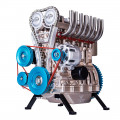Mechanical Building Kits
Gears in Motion: Mastering Mechanical Building Kits
Mechanical building kits let people of all ages explore the fascinating world of engineering, get lost in the details of its gears and mechanisms, and build the devices of their dreams. Motorized workings are fun in and of themselves! This guide will provide you with tools, strategies, and insights to help you achieve mastery of these kits and bring their challenging builds to life. Plunge into the world of cogs and movement with ease and accuracy.
The Allure of Mechanical Building Kits
Mechanical kits foster creativity, building and strengthening problem-solving skills as they create fun mechanical models such as locomotives and automata. These dynamic parts and the results they yield have artists and tinkerers flocking to them. Knowing why they are so attractive develops momentum to learn the skill.
Engaging Complexity
These kits engage builders with complex systems, like gear trains or crankshafts, that parallel the workings of reality. Piecing parts together and making them move helps to develop analytical thinking. The challenge keeps builders entertained for hours.
- Brain Bending: Boosts spatial reasoning and logic.
- Realistic Results: Produces a model of lifelike movement.
- Long-Term Interest: Complex construction keeps it engaging.
Hands-On Learning
Kits such as these teach children the principles of engineering, from torque to leverage, by showing them how these forces play out in real life. Every truss adds insight to machine design logic. This hands-on learning resonates with people who like to tinker.
- Hands-On Skills: Discover the math behind gear ratios and mechanical linkages.
- Engineering Insight: Integrate actual machine operations.
- DIY-Crafty Appeal: Emulates crafts or shop classes.
Display-Worthy Creations
Finished kits, such as a wooden clock or metal tank, are transformed into striking decor or conversation pieces. Their purpose—neither wheels meant to roll nor gears to turn—provides visual interest. Water is visible, and builders like to show off their work.
- Beauty Value: Form and function together at last.
- Shelf Pride: Perfect for shelves and desks.
- Ice Breaker: Chat-provoking among your guests.
Mechanical Kit Components Explained
Mastery starts by understanding the parts that make motion go. Most such kits contain gears, axles, and motors, all of which are essential to powering motor vehicles. Developing a relationship with these parts makes service/fault-finding easier.
Gears and Linkages
Gear ratios transmit movement and strength, so that rotation or oscillation occurs. Motion is directed along linkages, similar to levers or cams. The correct alignment provides for easy slipping.
- Types of Gears: Spur, bevel, or worm for versatile movement.
- Joints & Pivot Points: Steering control or force multiplier.
- Compatibility Requirements: You have to install correctly to avoid becoming stuck.
Power Sources
Kits' power mechanisms with rubber bands, springs, or hand cranks. Electric motors are incorporated in some of the more sophisticated models. Understanding the power source dictates the way it is assembled and serviced.
- Rubber Band Power: Rubber bands can hold and release energy.
- Spring Mechanism: Maintains constant power for clocks.
- Power Options: Complete kits can be automated.
Structural Elements
The skeleton is made of frames, plates, and axles, on top of which moving clock parts are placed. The materials, including wood, metal, or plastic, also dictate durability and weight. Solid frames prevent shaking and falling.
- Frame Stability: Stabilized to keep gears in place.
- Material Choices: Wood = warmth, metal = strength.
- Axle Bearing: Enables the axle to rotate freely without friction.
Choosing the Right Kit
Choosing a kit that suits your skill level and interests results in a humbling and satisfying experience. Think about complexity, theme, and build time. They help steer you to the right project.
Skill Level Assessment
Newbies will want to start with kits of 100 to 300 pieces, such as UGears’ Hurdy-Gurdy, while seasoned builders can tackle 500+ piece models like TimeforMachine’s Sparkling Engine. If things are too hard for the player, it’ll only frustrate them.
- Easy Elementary: Easy; fewest actions, which are obvious what you can do.
- Intermediate: Medium gear, 4 to 8 hours.
- Expert: Complicated builds, multi-day assemblies.
Theme and Interest
Kits cover subjects as diverse as vehicles, clocks, or steampunk gizmos. Pick by passion—car nuts will enjoy a V8 engine model, while history buffs might prefer a trebuchet. Background congruence increases motivation.
- Vehicles: Cars, trains, or tanks with moving parts.
- Historical: Catapults, musical clocks, or music boxes.
- Science Fiction/Steampunk: Robots or anything futuristic.
Build Time and Commitment
Some kits take an hour to build; others are projects that can extend over weeks. The busy may prefer something quick, such as Hanayama gear puzzles, the dedicated a longer challenge, like UGears’ 16-hour Locomotive. Evaluate the amount of time that you have to work with before you begin.
- Fast Builds: Spend 1–3 hours for instant gratification.
- Moderate Projects: 4–10 hours, for weekend-only fun.
- Long-Term: Up to 10+ hours for engrossing challenges.
Tools and Workspace Setup
A good workspace will help you do a better, faster job. Necessary tools and a clean area help prevent any mistakes and protect fragile parts. Prepared in such a way that you can build it with no problems.
Essential Tools
Tiny parts are manipulated with tweezers, pliers, and small screwdrivers. A cutting mat keeps things safe, and a magnifying glass comes in handy for finicky work. Sandpaper is used on wood parts if necessary.
- Special Tools Needed: Small pairs of tweezers to place the gears and perhaps pliers to adjust bends.
- Surface Protection: Cutting mat or cloth for stability.
- Detail Aids: Magnifier for fine assembly work.
Workspace Organization
Have a large, well-lit table with trays or bowls for sorting parts. Storage is mid-build with puzzle mats or boards. Keep the manual and reference images completely handy.
- Illumination: LED adjustable light for clarity.
- Sorting Trays: Sort gears, screws, and axles.
- Storage Option: Mat or box for hibernating projects.
Safety Gear
Always wear goggles when cutting or sanding, especially with metal kits. Wear gloves for sharp corners or chemical finishes. Have a first-aid kit for minor injuries on hand.
- Protection for the Eyes: Protection against dust or debris.
- Protection for Your Hands: Gloves for metal or rough wood.
- Emergency Prep: Band-Aids for small cuts.
Step-by-Step Building Process
It just works—on a system level, a reliable assembly of the device produces something done. Simply move through complicated mechanisms like following these easy steps. The phases each take you to a functional and refined model.
Step 1: Review the Manual
Read the instructions carefully before starting the job. Make a note of any special tools and steps, as some of these things are not reversible. Get to know part names and diagrams.
Step 2: Sort and Check Parts
Sort parts and inspect for foreign particles. Tray pieces by type—gears, axles, frames. Inspect missing or damaged parts; if you find some problem, please contact us! Prepping in advance alleviates time during assembly.
Step 3: Build the Fundamental Structure of the Base
Lay down your frame or chassis on the ground, moving components. Stability—both T connections and level connections help the button fit more tightly. A stable base will ensure no mishaps with equipment relays.
Step 4: Install the Gears and Mechanisms
Install gears and linkages following the manual; spin and note if smooth. Dry run movement to detect misalignments as early as possible. If advised, use supplied kit grease.
Step 5: Add Power Source
Attach rubber band, spring, or motor as directed. Check the action to be sure it moves freely. Move it around one way or the other if the motion slows down.
Step 6: Final Testing and Finish
Check the complete system for smooth operation, and correct any jams or loose parts. Sand or paint to suit if desired. Clear the workspace and retain the leftover parts.
Mastering Common Challenges
Mechanical kits have obstacles such as gear misalignments and fragile rock. Preemptive measures can thwart these problems. These strategies will help keep your build on track.
Gear Misalignment
Gears that jam or skip frequently arise from incorrect spacing or dirt. Re-mesh gears to specified tolerance according to the manual. Dust parts using a soft brush.
- Verify Spacing: Employ the spacers or guides in your kit.
- Clean Gears: Blow grit out with compressed air.
- Test Slowly: Hand crank to find any problems.
Fragile Parts
Wooden or delicate pieces of metal can snap if pushed. Carefully pull away (you can use tweezers for small parts). Don’t push too hard when assembling.
- Delicate Workmanship: Never make scrunching; no twisting.
- Tool Use: Tweezers or soft pliers for accuracy.
- Replacement Parts: Access replacement parts through the manufacturer.
Complex Instructions
Complicated manuals may befuddle builders. Let yourself break down the instructions, one part at a time. Watch online videos or read forums if you want visual help.
- Incremental Focus: Do one thing at a time.
- Visual Aids: Search YouTube for kit-specific tutorials.
- Community Help: Join https://old.reddit.com/r/modelmakers.
Core Concepts Through the Most Advanced Methods for Mastery
Step up your game with advanced tricks for advanced kits. These methods improve precision and productivity. Add them to obtain professional-quality results.
Dry-Fit Testing
Add parts without glue to make sure everything fits and moves. This eliminates the possibility of mistakes in transmission installation or wrongful assembly. Tweak before gluing or screwing down.

